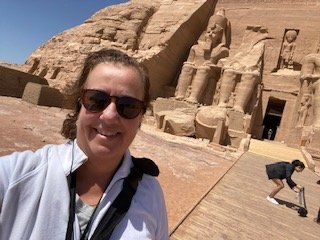#38 To Abu Simbel and Back to Cairo
This is my last travel blog entry for Egypt. I want to finish before I leave on another trip. Some of the best was saved for last. We checked into the Sofitel Old Cataract Hotel in Aswan for only one night. This was truly a shame because this was one of the most beautiful and spacious suites I have ever seen. The view from the seventh story balcony was spectacular.
View of the Nile in Aswan by Joan Naidorf
The hotel is famous for having hosted every famous person and author who ever traveled to Upper Egypt. The actual room Agatha Christie occupied while writing Death on the Nile is located in the hotel’s original building. Some of the scenes from the novel take place at the hotel. The very scenic 1902 Restaurant located in the hotel was iconic but the food was meh.
Early the next morning, the group was bussed out to the airport for a 45-minute plane ride to Abu Simbel. Located just 35 miles north of the Sudan border, the enormous temple complex was on its way to complete submersion by the newly constructed High Aswan in the early 1960’s. With money raised by the international community, the entire complex was moved from its former location to a site nearly 100 feet higher overlooking the waters of Lake Nasser.
The Great Temple at Abu Simbel photo by Joan Naidorf
Interestingly, the temple fell into disuse over the centuries and were nearly covered by sand. In 1813, a Swiss researcher found the temple frieze leading to the temple rediscovery. The re-location project was an expensive (40 million in 1964) that occurred between 1964 and 1968. Fascinating footage of the relocation efforts can be found on YouTube. Any signs of the “cutting” and relocation can hardly be seen.
The Great Temple at Abu Simbel, which took about twenty years to build, was completed around year 24 of the reign of Ramesses the Great (which corresponds to 1265 BC). The entrance is flanked by four colossal, 66 ft statues, each representing Ramesses II. The statue to the immediate left of the entrance was damaged in an earthquake, causing the head and torso to fall away; these fallen pieces were not restored to the statue during the relocation but placed at the statue's feet in the positions originally found.
Inner Hall at Abu Simbel photo by Joan Naidorf
The interior of the Great Temple at Abu Simbel is also fantastic. The hypostyle hall 59 ft long and 55 ft wide and is supported by eight huge pillars depicting the deified Ramesses linked to the god Osiris. I took the picture below to show the massive scale of this monument. The walls are adorned with multiple engravings and paintings that were all preserved in the move.
The Small Temple at Abu Simbel photo by Joan Naidorf
The temple of Hathor and Nefertari, also known as the Small Temple, was built about 100 m (330 ft) northeast of the temple of Ramesses II and was dedicated to the goddess Hathor and Ramesses II's chief consort, Nefertari. It appears a little petite next to its great neighbor but it is still a very highly adorned and impressive temple. A fellow traveler took a nice picture of my husband and myself. I was doing my best to add to my ultimate selfie collection in front of the Great Temple. By the time our group left the complex, our was the only bus in the parking lot. We drove back to the airport and flew back to Aswan and the palatial Old Cataract Hotel.
Abu Simbel Selfie by Joan Naidorf
We used our free time to visit the lovely Nubian Museum located around the block from our hotel. The promise to build the museum was made when much of the native lands of the Nubian people in Egypt were going to be flooded by the damn project. The largest part of the museum is occupied by the monumental pieces, reflecting phases of the development of Nubian culture and civilization. A small collection of pre-historic cave art fragments demonstrates just how old and rich the Nubian culture was and still is.
Small Sphynx at the Egyptian Musem in Cairo picture by Joan Naidorf
Sadly, we had another early morning wake up call to get ready for an early flight back to Cairo. We stopped for lunch and then visited the venerable, pink Egyptian Museum. The collection of treasures is unparalleled in the world. The treasures of King Tutankhamun are on display along with the ornate burial sarcophagi taken from the Valley of the Kings. The Iconic gold funerary mask is on display here for a future move to a new museum planned to open in the coming year.
A treasure from the Egyptian Museum photo by Joan Naidorf
Our last day was spent visiting some of the more modern religious sites in Cairo. The most famous Christian site is the Hanging Church is named for its location above a gatehouse of Babylon Fortress, the Roman fortress in Coptic Cairo (Old Cairo). The original church was built in the Third century and rebuilt in the Sixth century. The church was hidden within the neighborhood to prevent hostile invaders from destroying it. The Church contains many floors, carvings and religious icons that have been laid upon each other over the centuries.
The Hanging Church in Coptic Cairo photo by Joan Naidorf
The current chapter of religious tradition left in the country was introduced during a visit to one of the most famous mosques in the city. The Great Mosque of Muhammad Ali Pasha or Alabaster Mosque is a mosque situated in the Citadel of Cairo in Egypt and was commissioned by Muhammad Ali Pasha between 1830 and 1848. Of the nearly 20 million people living in Cairo, almost 90% identify as Sunni Muslim. The once pluralistic society has alienated many of its cultural and religious minorities.
I asked about the Jewish population and was told that the Synagogue in Old Cairo was being renovated. We were told only ten Jewish people were left in Cairo. The guides view themselves and their people as accepting and respectful of other religions but the facts tell another story. The religious shrines are heavily guarded and monitored. In 2016, a bombing near St. Marks’s Coptic Christian Cathedral killed 25 people. Another bomb was thrown at a synagogue in 2010.
We wrapped up our final day in Cairo with a lovely reception and dinner with our fellow travelers. We left the hotel in the early morning hours to get to the always bustling Cairo airport. The day of travel stretched nearly 24 hours and was punctuated by a random search of our luggage by the TSA folks at Dulles airport. This occurs even with a Global Entry membership and includes a complete unpack, inspection, and palpation of EVERY PIECE of clothing, underwear, and shoes.
The surprise inspection added an hour while I knew our pup was waiting at home in her crate. Not the way I would have written the ending to the trip of a lifetime but nice to feel safe. We were so grateful to find a time of stable government and pandemic stability to take our trip to Egypt. It took several years of planning, cancelling and rescheduling to get there. It is worth every penny and then some, so start saving and planning for the experience of a lifetime.








